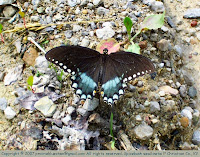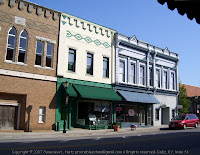Chores and Duties... Life in Christian County, Kentucky...

Sticker each voter received
at the election Tuesday
I read an article in the newspaper a month or two ago that said poll workers were needed, and I decided I'd try it. I filled out some very simple paperwork at the county clerk's office and was hired.
A few weeks ago, I went to a class about being a poll worker. A man from the Kentucky Secretary of State's office taught it. It was detail intensive, and he said many times, "We don't want to see your name in the newspaper."
The class frightened me a little. I was especially worried about getting the machines set up properly -- one of my responsibilities as an election judge. We were shown how to do it in the class, but we could only watch. There were too many in the class for us to actually practice doing it.
Yesterday I worked in an election for the first time ever. I didn't sleep very well the night before. I got up about 4:00 a.m. and arrived at the polling place at 5:15. The other workers arrived before long and we started getting things set up.

Carefully following the instruction sheets given to us at the class, the other judge and I opened the two machines for voting without too much trouble. One was an old-style machine with curtains that is being gradually phased out, and one was a new machine called an E-slate (pictured at right.)
At 6:00 a.m., we had several voters waiting to come in and several more came in before 8:00 a.m. Then the trickle of voters slowed down to a drip, and the day went very slowly. We had another small rush from about 5:00 p.m. until the doors were finally closed at 6:00 p.m.
The other judge and I had to set the machine for the correct party every time someone voted. Since it was so slow, we tried to get as many people as possible to use the new machine. We had plenty of time to show them how to twirl the dial to make a selection and then press "Enter" to record it.
It was a primary election for Kentucky state officials. The voter turnout all over the state was very low. Where I worked, we had about 13% of the registered voters in the precinct. It's too bad about the apathy, but I was thankful that it wasn't very busy since it was my first poll-worker experience.
I had a book of Willa Cather short stories with me, and I read "A Death in the Desert" and "Neighbour Rosicky" during the slow spells. (I had read them both before, but I enjoyed the re-read.)
The other judge (a man) also brought a book, and the clerk and the sheriff (two ladies) talked all day. They had been in the same class in high school about fifty years ago, and they had a lot to catch up on.
I was also nervous about shutting down the machines, running the tapes, removing the last seals, and filling out the reports, but we followed the directions, and I haven't heard anything yet about us not doing it right -- or seen our names in the newspaper!
After we got everything packed up at the voting place, the other judge and I had to take everything except the voting machines to the courthouse in Hopkinsville, turn it all in, and sign another paper.
We were told at the class that there would probably be a Democrat run-off election in June for the governor's race. However, a candidate (Steve Beshear) did get over 40% of the vote, so a run-off is not required, and the next election will be in November.
 EAC - Become a poll worker.
EAC - Become a poll worker. This link gives a contact number for poll worker information in all 50 U.S. states.














 Every coffee drinker has a little story about when and why he/she started drinking coffee.
Every coffee drinker has a little story about when and why he/she started drinking coffee.
















